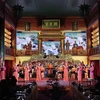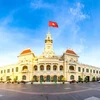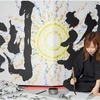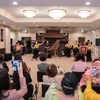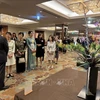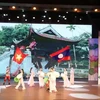 The artisans are required to have experience and skills in the silver-plating stage of the artwork. (Photo: VNP/VNA)
The artisans are required to have experience and skills in the silver-plating stage of the artwork. (Photo: VNP/VNA)  The base of the product is wrapped in chiffon fabric before the art is applied to the new surface. (Photo: VNP/VNA)
The base of the product is wrapped in chiffon fabric before the art is applied to the new surface. (Photo: VNP/VNA)  Ha Thai lacquer is listed in the ‘One Commune, One Product’ programme of Hanoi capital city. (Photo: VNP/VNA)
Ha Thai lacquer is listed in the ‘One Commune, One Product’ programme of Hanoi capital city. (Photo: VNP/VNA) VNA


